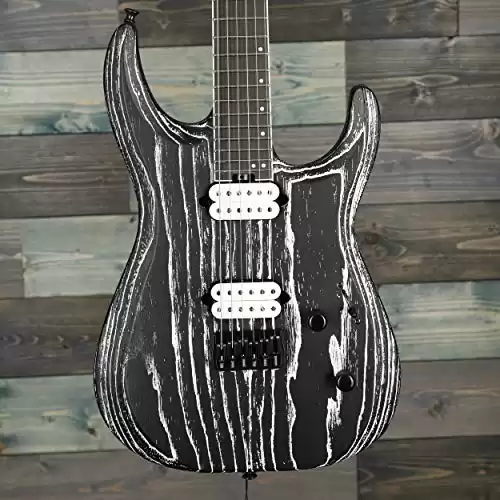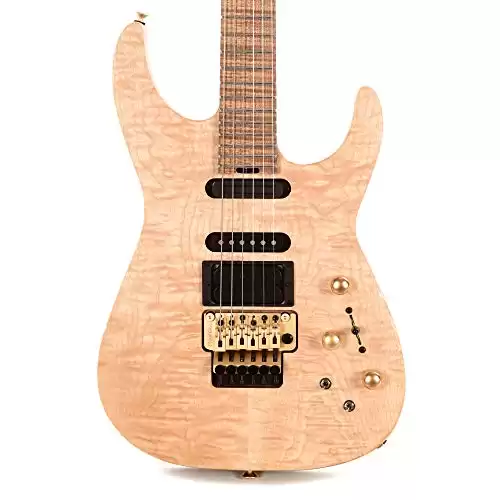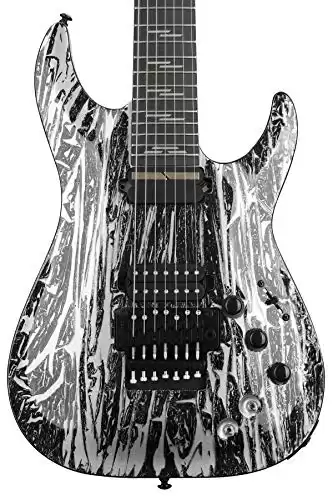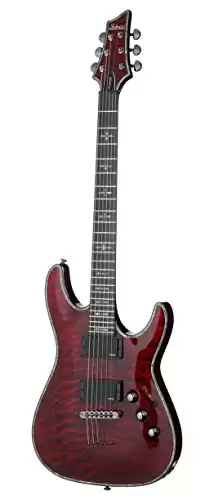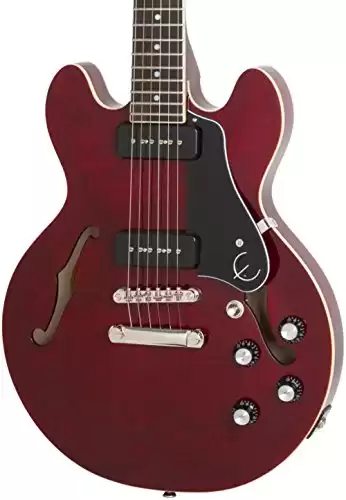Although you can shred on a thin guitar neck like crazy, that design can also cause extra physical wear and tear on your body. The demands of fast chord changes and note riffs are too much to take for some musicians.
That’s one reason to consider looking at the best guitars with thick necks.
Another option involves your personal preferences. Some musicians prefer an instrument with some extra heft to it, especially if their role is to produce massive power chords.
You can also find musicians who like guitars with thicker necks because they feel more comfortable to use.
Although everyone has their personal preferences, this guide will take you through the essential guitars you’ll want for your collection if you like playing on a thicker neck.
Best Guitars with Thick Necks
The benefit of playing the guitar with a thicker neck is that less squeezing is involved when holding the instrument. Since that muscular contract can lead to cramping, tensing up, and even finger twitches, it’s often easier to plant a thumb and reach the desired chord combinations.
When you start playing the guitar, your goal should be to get as comfortable as possible with the instrument.
Although a thicker neck adds some extra mass that could impact your overall tone, thinner designs often increase the speed and accuracy of how you play.
If you switch to a thicker neck from a thinner one, you’ll often notice an increased sustain right away.
Most guitars stay in tune better with the extra mass, ensuring that your setup remains the same between gigs or practice sessions.
Some musicians say that they can tell there is a better tone, although those who like thinner necks would say the same.
The only way to tell what you prefer is to get your hands on a few instruments to try them out. Musicians with bigger hands typically like the design of a thicker neck, while those with less physical reach tend to play better with a thinner design.
There’s a myth out there that guitars with thicker necks are meant for more experienced players. That’s not necessarily the case. You can find people who prefer specific neck shapes, nut styles, or even fretboard components.
The best guitars with thick necks are for anyone who prefers that shape and style.
What Are the Best Guitars with Thick Necks?
If you’re ready to start playing a guitar with a thicker neck, here are the instruments that you’ll want to consider adding to your collection today.
Each one provides a significant benefit that can enhance the quality of your playing.
1. Jackson Pro Series Dinky DK Modern Ash HT6
Although this guitar is a 7-string design, you’ll find that it still provides the features you want as a technical musician.
It blends brightness and warmth into friendly tones while creating excitement within the mid-range.
The best characteristic you’ll find is the multi-voiced Fishman humbuckers that churn out some impressive styles.
Although the Jackson Pro Series Dinky DK Modern Ash HT6 delivers an ergonomic design, you’ll appreciate how the neck thickness translates into an improved playing style.
It offers a double-locking tremolo for lots of whammy love while keeping the tuning during and after each session.
You can grab it in several different color combinations, but it is the green guitar that stands out from the pack with this Pro Series instrument.
2. Jackson USA Signature Phil Collen PC-1
When your priority is to improve the tone that you produce with your style, this guitar delivers an unreal result.
You’ll find more crispness and clarity with each note and chord than with virtually any instrument available today.
Not only does the sound project to the back of the room, but you also eliminate the distortion and fuzz that can make some compositions challenging for the listener to hear.
If you play in a metal band, the Jackson PC-1 will hit the power chords, take on the melody, or give you options to create scorching solos. It’s also versatile enough to work with other musical genres.
What stands out is the sustain pickup in the neck position that seems to continue forever.
You can opt to turn it off, choose only the harmonics, or adjust things in several other ways. The jumbo nickel pickups are incredibly fantastic.
3. Schecter C-7 FR-S Silver Mountain Guitar
If you select this guitar for its thicker neck, you’ll appreciate the stainless steel frets that come with the design immediately.
When that trait combines with the Floyd Rose trem, the massive pickups, and the ebony fingerboard, you’ll get saluted by those who are about to rock. The manufacturer even includes a Sustainiac pickup in the neck for an ongoing ring that you’ll adore.
When you start playing the Schecter C-7 FR-S Silver Mountain Guitar, you’ll notice the improved sonic density immediately.
The explosive tone comes with lots of harmonic content, promoting a solid sound-shaping potential that you can’t find in other models.
All it takes is a few tweaks of the tone knobs to get the results you want, especially with today’s best pedals and amps.
The mahogany body on this guitar ensures you get a vibrant blend of sustain and warmth without being too heavy or thick for shredding.
4. Schecter Hellraiser C1 Electric Guitar
Today’s music requires fast-paced playing to keep up with the beat. If you have a guitar with a thicker neck, it can sometimes feel like that outcome isn’t possible.
After hearing this instrument’s EMG 57 active humbucker combined with the Sustainiac, you discover a broad tonal range that can enhance any musical genre.
The Schecter Hellraiser C1 electric guitar is built with the musician in mind every step of the way. You receive endless controllable sustain and a hot-rodded PAF-style sound that adds character and grace to whatever composition you play.
There’s a slight scoop in the mid-range, plenty of clarity in the top end, and warmth in the lower frequencies to deliver an impressive result.
Schecter uses quilted maple to increase your notes’ attack rate, while the compound-radius fretboard ensures you have comfortable chording for those longer playing sessions. It even includes glow-in-the-dark components so that you can play accurately on a dark stage
5. LTD Viper 400
When you grab this guitar with a thick neck, you’ll find EMG active pickups waiting for you to use. Although the scale is 27 inches, the jumbo frets make it relatively easy to play.
The solid body design is optimized for lower tunings to create an aggressive sound with its humbuckers. It also comes with a TonePros TOM bridge for fantastic string response and tuning stability.
The LTD Viper 400 is made primarily from mahogany, although the fingerboard is pau ferro.
You’ll get a three-way toggle switch for the pickups, a master tone control, and a volume knob to use on the instrument. The EMGs growl with delight, allowing you to take advantage of its incredible sustain.
6. Epiphone Sheraton II Pro
Since a thicker neck tends to add more weight to a guitar, designers take different steps to balance the difference in other areas.
The semi-hollow body works with a three-piece maple neck to get tone, playability, and stability, all wrapped up in one convenient package if you select this option.
You’ll get a pair of in-house ProBucker pickups as part of the standard package, offering a bit of vintage chime that everyone will adore.
If you have ever listened to the blues or rock songs from the 1960s, the Epiphone Sheraton II Pro will sound familiar.
It can give you a bright and aggressive tone if you want, but where it shines is when you use the overdriven tones for smoothness and warmth.
The guitar comes backed with a limited lifetime warranty to protect your investment even further.
When you include the classy touch of the golden hardware for the aesthetics, you’ll discover that this affordable guitar with a thicker neck is a lot of fun to play. You’ll be thoroughly impressed by what it can do.
7. Gibson SG Faded Special
Santana immortalized this guitar with his performance at Woodstock. If you’re a little on the older side, you might remember Pete Townshend smashing this instrument on stage.
When you want to play an iconic sound and design, you cannot go wrong with an investment in the Gibson SG Faded Special.
You could purchase one of the originals or a special edition if you love the trademarked Gibson sound, but you’ll save $6,000 or more by grabbing this instrument instead.
It features a bound rosewood fingerboard, Plek’d frets for the right action, and contoured mahogany to give you that incredible sound you want for all-day play.
Once you get past the aesthetics and initial sounds, you’ll discover that the chrome hardware and deluxe tuners work well to create vintage optics and chords that bring the listener back to a different era.
With several different colors from which to choose, you can’t go wrong when deciding to add this guitar to your collection.
8. Fender Clapton Strat
When you pick up this guitar for the first time, it feels like you’ve made it as a musician. The balance is perfect, and you’ll get to enjoy the classic design that Fender has used for several generations.
It feels like you’re getting ready to play the old Rock Band video game, but for real this time.
Once you start playing the Fender Clapton Strat, you’ll discover a 25 dB boost in the mid-range that works well for propelling tube-based amps to a successful result.
The sustain is impressive, creating something similar to a cello or a violin. It incorporates three noiseless pickups to deliver that vintage Strat sound without having humming in the background.
Clapton’s idea for the guitar is to add a wood block on the tremolo so that the instrument works more like a hardtail.
If you remove that piece, you’ll get it to work as intended. When the tone is your primary concern, you won’t find a better pound-for-pound investment to enjoy adding to your collection.
Does the Neck Shape or Profile Matter with Thickness?
When you shop for a guitar, you’ll find that neck thickness is only one of several considerations you’ll need to review before selecting the perfect instrument.
After you decide on the wood preferences for your neck, you’ll need to think about what shape you want. Almost all of them fall into one of three options: C, U, or V.
Each neck shape has some specific characteristics to review so that you know for sure that you’re getting the instrument you want.
■ The C Shape for a Guitar Neck
When you have a guitar with a C-shape neck, you’re using the most common design element found in the industry today.
This choice is relatively comfortable for the average musician as it works well for everyone except those who have large hands.
Although Fender guitars (and a few others) have a flatter shape to the “C” dynamic, the design’s premise remains the same.
Several different versions are out there, including thicker styles that support authentic, well-sustained sounds.
■ The V Shape for a Guitar Neck
If you have a guitar with a V-shaped neck, you’ve got a traditional design that enables the musician to hold a thumb over the fingerboard to hit the bass notes. That leaves the rest of your fingers free to hit the melody lines or the harmonic chords.
Two choices are available with this design option. You can see a rounded V-shaped neck or the hardstyle.
You’ll find the latter on many older model re-issues and vintage products, but they’re not usually incorporated into a later series.
The best designs are the ones that taper to almost nothing as you get closer to the nut.
■ The U Shape for a Guitar Neck
Musicians with larger hands prefer this neck style, especially when playing on a thicker design.
It works well for anyone who likes to keep their thumbs on the back or side of the neck. The most famous guitars that incorporated this option were the older Telecasters.
When you shop for a U-shaped neck, you’ll want to consider the design’s balance before deciding on the instrument you prefer.
Although some come with perfect balance, others tend to be thicker on one side. These options ensure that everyone can find their comfort zone.
What Are the Pros and Cons of Playing with a Thick Neck?
If you want to play the guitar with arguably the thickest neck ever created, you should grab the 1954 LP GT from Gibson. It’s more than an inch wide at the 12th fret, which is why many reviewers liken the playing experience to that of a baseball bat.
When a guitar has a thicker neck, it becomes less prone to shaping problems as it ages. The instrument is sturdy, but that also means players with average or below-average hand sizes might struggle to play without having pain.
Robert Schumann famously injured himself permanently by using finger-stretching machines that could help him increase his reach on the piano. Guitarists face a similar experience when the neck is too thick for their natural style.
If you want to compromise on thickness without getting a paper-thin option, guitars like the Martin 00-15M or the Kendrick Townhouse can help you achieve a signature sound without experiencing high discomfort levels.
Is It Better to Use a Guitar with a Thick Neck?
I’ve always found that guitars with thicker necks tend to be easier to play. That might be due to the old student acoustics I used to play at school each day. We didn’t have much money growing up, so my lessons were with my band teacher during my study hall.
Those times when I could just strum a guitar, feel the music flow through my body, and let the cares of the world pass me by were some of the best moments of my childhood.
After I transitioned to electric guitars, I found that the thinner necks didn’t suit my style much. I don’t bend the chords much to produce vibrato.
It’s more of a straightforward, in-your-face type of strum or note with a bit of added flair here or there.
I also like how a thicker neck keeps the strings further apart than the designs that use a thinner option. If things are too close, my fingers struggle to pick out the right pattern.
When you start shopping for a new guitar, the bottom line is this: if the instrument doesn’t fit your hand, you shouldn’t get that model. If it fits like a glove, there aren’t many other disadvantages to consider.


